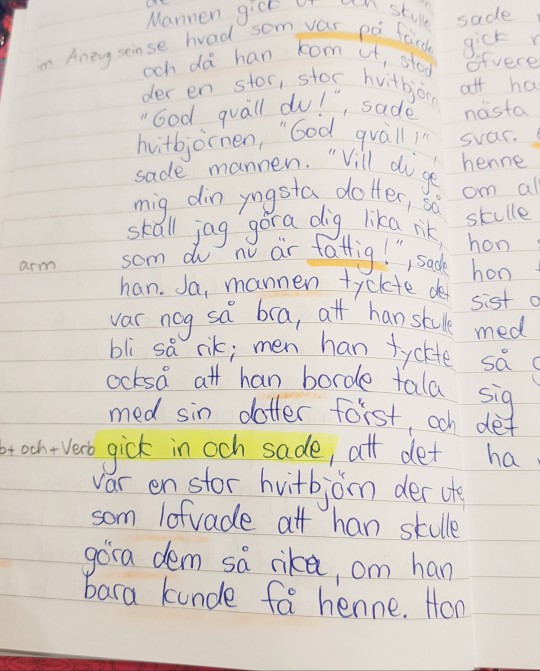I like interesting things okay??!!!Now leave....A place for weird people by weird people I was doomed to be here from the start....
Don't wanna be here? Send us removal request.
Text


And five minutes later they’re making out and sucking each others blood
395 notes
·
View notes
Text
Music Will Save Your SOUL (and your pronunciation)
Other blogs and articles and even books can tell you why you should listen to music while learning a foreign language, but they don’t really tell you how. So here are a few personal tips of mine for how to get the most out of music in your target language.
1. Listen, don’t read: A lot of people will say “go find foreign songs and look up the lyrics!” and I say hold up on the lyrics. When listening to music just listen. Don’t worry about meaning and words just let all of that go and focus on the music and the sounds. (Though if you like, you are allowed to look up a lyrics translation once just to get a basic meaning of the song but don’t get stuck on meaning quite yet.) This is important for learners of all levels. If you’re a beginner it can help you start off good pronunciation wise and for an advanced learner it can help you in places where your pronunciation could still use a little improvement. Imitate the sounds as best as you can, advanced learners this is important: forget how you “know” it to sound (i.e. how you’ve always been pronouncing it) and just listen and repeat exactly what you’re hearing. Because sometimes what you “know” it to sound might not be accurate. I still remember in my Chinese class some people pronounced words wrong to the bitter end because in the beginning they’d started off incorrectly, the teacher eventually gave up correcting them so they assumed that meant they had it right, and it never quite left. (Know I have nothing against accents in foreign languages the goal is to do the best you can and just ‘cause it’s your best doesn’t mean you can’t set a new best :) Let these songs get mixed into your regular playlists and let them just become a part of life.
2. Reference lyrics: Don’t sit there with your eyes buried in the lyrics, but keep them handy. Long after you’ve gotten a good gist of the song without ever reading anything you can finally look at the lyrics. But use them to check out the parts you’re not quite sure on. Some sounds in foreign languages can be difficult to distinguish, perhaps the distinction doesn’t exist in your native language. Here’s your chance to kind of start to know what you’re pronouncing. You might find a few sounds you missed (or were omitted intentionally) in the song. There’s also sounds that you’ve been hearing the same but seeing them spelled you realize they’re different. You’ve been listening to this song for so long it won’t take you long to start hearing and imitating that distinction. You might also notice some sounds that are different from written and that’s just an aspect of the language (like Russian o going to a when it’s unstressed) but now you’ve got it down the right way long before you even looked at the spelling which often confuses pronunciation more than it helps. You can learn where the word breaks are and sentence breaks because they’re not always clear in music. If you can add the lyrics to your song (you can do this easily with iTunes/apple devices I don’t know about other devices) so you can have them for reference every time the song comes up on a playlist. Continue this step until you can basically recite the song and have a native speaker understand you. For languages with different alphabets or tones, here’s how you should approach it: alphabets/abjads/syllabaries should be left in the original writing system, it’s good practice for you to learn to read especially in places where letter and sound don’t match/can change. This would include Cyrillic, as well as the Arabic writing system and the many writing systems used to write the many languages in south and south east Asia. Add accents if accents are a thing you need (even if they’re not normally written in casual writing). If you’re learning Japanese it’s okay write out the pronunciation for Kanji, but it’s best if you do it in one of the Japanese syllabaries (Hirgana/Katakana) and keep the original Kanji just put the hirgana next to it in parentheses or something to help you get used to the kanji. Delete it when you’re ready. If you’re learning Chinese do put pinyin with proper tones underneath each line of characters. Tonal languages: it is very important that you make sure your tones now come into play, like I said before, by the end of this step you’re going to want to be able to basically “speak” the lyrics, and often tones can get lost in music but can be key in speech.
Photo: Example of some lyrics on my iPod


3. Learn meaning: Last but certainly not least, now it’s time to learn the meaning of this song you’ve known for like ever now. But don’t just look up someone else’s translation and roll with it. You don’t know who made that translation or if it’s even good. Now if you started this journey with a song at the same time you started your journey with a language you should have quite a bit of vocab and grammar under your belt. Go over the lyrics in the target language and try and figure out what you can figure out without ANY dictionaries or translators getting involved. Sometimes you’ll be surprised, even as a beginner, how much of it you can actually understand. If you need a dictionary or translator for a word here and there, use it. If there are whole paragraphs you don’t understand, leave them. No one said you have to know it all know. Who knows, maybe later you’ll come across this song again and suddenly have the vocabulary/grammar to understand more of it. Keep working on it until you’ve got it all.
It’s important to remember this is just my own personal way of doing it. I’m sharing it because who knows, someone else out there might find it useful too. Often I feel like with music, particularly foreign music, it’s good to split it into pieces of sounds/words/meanings in that order. And when it is you work on the next part is up to you. Some of you might complete all these steps for one song in like a week. Others might keep at it for months. Work at your own pace. But if you’re going to spend extra time on any step, pick the one that matches your goal. If your goal is to help pronunciation, focus on the sounds step the most, words the second most, and meanings the least. If your goal is vocabulary/grammar then obviously you would prioritize them differently.
504 notes
·
View notes
Text
How I read and enjoy books in my target language
Please note that I write about what works for me and share advice based on my own experiences. If you have a different opinion or if you use other methods, that's absolutely fine. Do whatever works for you.
Since some people asked me how I read books in my target languages, I would like to describe my way of reading in this post. I focus on reading for some time now and I'm very happy with my progress so far. This doesn't mean that I won't change a few things in the future (I'm constantly gaining experience and changing my learning style accordingly).
1. Choosing a book
Before I start reading, I have to choose an appropriate book, obviously. After trial and error I realized how important this step is. My ideal book is:
not too easy (I won't learn much)
not too difficult (if I can't follow at least the rough story I won't enjoy it)
interesting (motivation to read it)
I try to choose a book that is slightly above my level so that I can follow the story without looking up too many words but also learn new words. I don't need to understand everything, but I don't want to feel lost either. Balance is important.
2. Trying the first chapter
After choosing a book that seems to be appropriate, I try to read the first chapter (and sometimes the first two chapters, if they are short). I pay attention to things like:
Can I follow the story?
Is the story interesting?
Do I like the writing style?
If I can answer (most) questions like these with "yes", I continue reading the book.
Do I only understand single words or sentences here and there? Do I have no clue what happens? Then I put the book aside for now and choose an easier one. There's no shame in admitting that this book is too difficult at the moment. Deciding what I don't read is just as important as deciding what I read.
3. Reading
If the level of difficulty is okay, I start reading the book. In my experience, the first few chapters are always the hardest. I need time to get used to the writing style, the used vocabulary and the story.
In the case of the japanese version of Harry Potter, the beginning was difficult because of the writing style. But after two chapters, I began to enjoy the story and so I continued. That's why I always try to read at least the first chapter. A book that seems difficult in the beginning can be very enjoyable once I've read enough pages.
When I come across an interesting word or a sentence I like, I highlight it. I try to not highlight too much stuff, though. Two, maybe three words per page is usually my maximum. Enjoying the story is my number one priority. I can read several pages without highlighting anything, even though there are words I don't know. As long as I don't feel the strong urge to look up a word, I just continue reading.
In many cases I can understand words from context and learn them over time just by seeing them again and again. That's why I don't look up words immediately. I wait to see if they come up more often.

After I finished one chapter, I look up all highlighted words and read the passages that contain these words a second time. This way, I can connect the meaning with the full context. I don't try to memorize the word; I just try to understand it in this particular context before I continue.
Most of the time, I learn words unconsciously. If the book is easy enough, it's not so difficult to guess the meaning of certain words. While reading, I don't focus so much on words I don't know. I just focus on following the story. I may not always understand every detail, but as long as I can follow and enjoy the story, everything is fine. I learn so much by engaging with the language in a meaningful way and enjoying the content. Sometimes, I even forget that I am reading a book in a foreign language!
I have to add, that I'm already familiar with basic sentence patterns and that I have experience with reading books in my target languages. I finished the book "Remembering the Kanji" which makes it easier to guess the meaning of words. Knowing lots of kanji is a great advantage.
I have still a long way to go, of course, but this natural way of learning vocabulary may not work well at very early stages because you need a foundation first. After you are familiar with the dialogues and example sentences in your textbook, graded readers are a good choice in my opinion. Graded readers can make the transition from textbooks to easy books aimed at (young) native speakers easier.
Tip: One thing that helped me is to take a card, write down words I looked up and put this card into the book. When I read it a second time, I don't need to look them up again. Reading texts more than once can help to get more familiar with new words. Plus, writing helps me to remember words better. Reviewing them in their original context is much more enjoyable to me than reviewing them with flashcards. In the picture below you can see how my cards look like:

4. Enjoy!
I made enjoying books my number one priority. This is what helped me to make much more progress than before. All I need is enough reading material at the right level and a dictionary. As soon as I get absorbed in a book, I don't think about learning a language. I just want to enjoy the story. The more experience I gain, the better I become at understanding the language as a result. There's no need to force it or to hurry.
What I like about just enjoying a book and learning words naturally is that it's so simple. I don't necessarily need my computer, a certain software, add-ons, ... All I need is something I can read. After reading a chapter, I only look up a few words as I described above and that's it. Then, I often feel so motivated that I want to read more. I read much more than before because I enjoy it so much.
627 notes
·
View notes
Text
Ways to practice talking without native speakers
(disclaimer: obviously it’s best with native speakers because they can correct you but if you can’t or want to practice more alone here are some ways)
talk to everyone and everything
i’m serious
talk to your pets
talk to yourself
when you stub your toe and scream at the offending object scream at it in your target language
talk to your siblings to annoy them
make your friends guess what you’re saying (just don’t do this one too much)
watch bad movies and yell at them for being terrible in your target language (speaking AND listening)
when pollers call up pretend to only know your target language
describe what you’re doing to yourself
tell yourself stories
annoy your siblings some more
count stuff in your target language
sing along to your favorite songs in your target languages
when you imagine scenarios imagine them in your target language
just TALK
even if you’re not talking to native speakers it will make the words come out of your mouth with less hesitation
664 notes
·
View notes
Text
Language Learning Tip #2
Copying texts into a notebook
Choose some short & fun texts, something like fairy tales, local news, wikipedia entries etc. in your target language and copy the text into a notebook, leaving a bit of space at the side. Then go over the text again and mark any words you didn’t know & write down their translation or definition next to the text. Also check for any unknown & difficult grammar you noticed and mark that in a different colour.
By writing in your target language (even if it’s just copying) you’ll get used to the sentence structure and overall grammar of your target language. If you do this regularly, you’ll soon find it more easy to form and produce sentences by yourself!

720 notes
·
View notes
Text
Reyna’s tips on learning a language by yourself
Before we start, let me just say that all these things are tips and suggestions, NOT a sequential To-Do List. You can pick and choose what to do from here, but I STRONGLY recomend doing at least one thing from each category (reading, writing, speaking, listening). Some things might work for some people, some might not. I’ve tried to include as many tips I could think of, many of which have helped me. If you have some tips that I don’t have here, please reblog this post and add them!
(Here you go, @estudlante!)
***
Immerse yourself
speaking:
talk to yourself, repeat words you have a hard time pronouncing (look up pronunciations on forvo.com)
talk with native speakers! ask around on tumblr, join chatgroups, find a pen pal–just talk to someone! ask them to kindly correct your mistakes. (NB: do NOT be ashamed of mistakes, okay? You and everyone else made a million while learning your first language. It’s only natural to make them in your TL. And mistakes are good! When you make a mistake, find out what happened and adjust your speech/writing/whatever to fix that mistake. That’s how you learn.)
find a study buddy–someone who can help motivate you and practice speaking with you
listening:
watch tv (w/ subtitles in your native language at first, then switch to your target language–TL– as soon as you’re able to read in it. later on, for listening practice, turn off all subtitles)
listen to podcasts
listen to music (look up the lyrics and sing along)
watch youtube videos (of something you’re interested in, of course. look up movie reviews if you like those, or drawing tutorials, etc)
listen to the audio of a book while you read it. That way, you can practice reading AND hear how the words are pronounced all in one go
reading:
read books out loud (children’s books are great for beginners. i highly recommend reading those)
fanfic, meta, blogs
change the language settings on electronic devices
when you come to a word you don’t know, you can either (a) circle it, keep reading and try to understand it through context, and look it up later and write the definition down, or (b) look unfamiliar words up as soon as you see them and write the definition down. Either one you choose, write.that.definition.down.
writing:
write (fanfic, journal, a movie review, a summary of each chapter of the book you’re reading [can be in your TL or not], your plans for the day)
if you like to draw, draw a picture of what each vocab word represents and write the word next to it in fancy lettering
write vocab words on Post-Its and put them on things around the house, saying the word when you see the note (eg: la lampada on a lamp, los zapatos on your shoes)
start a course on Duolingo, Memrise, Babbel, etc
get chatting apps (HelloTalk and HiNative are the best things ever)
basically, just live your TL. that’s how you learned your native one, and it only makes sense to learn your TL in the same way
Study!
make flashcards
learn conjugations, vocab, etc
write sentences using new vocab
read grammar books
get a book in your reading level in your TL and copy by hand some sentences. Doing that will take your focus off of what the sentence is saying and put it on how the sentence is structured. That’ll help you in prepping your brain for constructing sentences of your own in the future.
basically, you want to understand the skeleton of the language so that you know how it works. Once you know that and vocab, making your own sentences (instead of pre-set ones from phrasebooks) will come so much easier.
Be.Disciplined.
make a schedule. include times to just ‘relax’ in your TL and times to 'study’ grammar
set goals (watching one movie in your TL a week, or reading three chapters a week, or writing five sentences a day. Pick something and stick with it.)
use a reward/point system. promise yourself a treat (food, an outing, an episode of your fav tv show) after you’ve reached a reasonable goal
push yourself. Learning a new language is challenging, but very rewarding. Remind yourself frequently of the reasons you’re learning this language to motivate yourself.
Above all, have fun and don’t get discouraged! There are so many langblrs out there willing to help if you have questions or just want to talk. Happy learning!
2K notes
·
View notes
Photo

I’ve been asked a couple of times now what my approach to self-study is, and this is my messy attempt to answer that question. All of this is true for me, and might not work for someone else; still, I hope it may help somebody!
1. Getting acquainted with the language
When you’re learning a language with a different writing system than your own, that’s the first thing you have to tackle, of course; but I usually try to get some background information even when the alphabet used by my target language is the good old Latin one. One thing I pay extra careful attention to is phonology: you want to get the sounds right from the very beginning, before you develop any bad habits (also, learning IPA changed my life). Having an accent as close to a native’s as possible is not necessarily the goal (I do like to work on that, but to each their own), but being understood is! And incorrect pronunciation can sometimes hinder comprehension, in some languages more so than in others. So don’t obsess over it, but don’t overlook it completely either. Getting to know the sounds of a language right away can also help you understand what people are saying a little quicker, and figuring out how new words might have to be read. Wikipedia is usually not bad when it comes to phonology, and Omniglot is a good resource as well.
2. Finding a good textbook
I’m a free spirit so I often find myself not looking for a textbook right away, and just chaotically absorbing information from different sources (see immersion below). When I do set my mind to choosing, though, I try to stick to one well-made textbook that I like, which should possibly contain clear grammar explanations as well as exercises. The temptation to hoard resources is strong – and I’ve succumbed to it myself more than once haha –, but I usually try to steer clear from using more than one textbook at the same time (although I do have separate, more thorough grammars on the side more often than not). I’d rather use a physical book if I have the chance, but if that’s not your thing or you don’t have money to spend on that, that’s okay: you can find loads of perfectly good books or websites online!
3. Compulsive translation
Anyone who’s been following my blog for a while probably knows that I love translating virtually anything: from songs to poems to short stories. It’s something that has always been a part of my life, and I thoroughly enjoy doing. It’s also an awesome language learning technique, which will help you enrich your lexicon and teach you tons of new turns of phrase in your target language. It works both if you translate from your native into your target language and vice versa: find a good bilingual dictionary (I prefer paper dictionaries because they provide more examples of usage, but again, you do you) and look for equivalent expressions, don’t just translate word for word! It might work sometimes but not always. When it comes to translation, Reverso Context is a great resource for some languages, because it provides translation in context, taken from a massive corpus heavy on subtitles – which you shouldn’t trust all the time, but will help you as long as you put some critical thinking in.
4. Immersion (you don’t say)
What a surprise, right? I usually start listening to music / watching video content right away; I wasn’t that big on YouTube before but language learning has made me change my mind. You don’t have to get everything: even if you understand 3 words out of 20, this will help you grasp the rhythms and intonations of the language. This depends on how many similarities my new target language shares with the ones I already know, but as a general rule I use Italian (or English) subtitles in the very beginning, then move on to subtitles in the target language and finally get rid of them entirely. Some people will argue against subtitles in any shape or form, but I can only speak for myself and they’ve helped me quite a lot in the past. The way I see it, reading is also essential: if I don’t have time to leaf through novels, I usually check out at least an article a day in my target language and write down the words I don’t know, plus their Italian translation.
5. Routine – the good kind
In short words, I strive to make the new language a part of my life. There are a thousand things you can do: change your phone settings? Great! Check out the news? Even better! If you’re out of ideas, here are a few suggestions. And don’t worry if you struggle at first: in fact, the start of this process is a bit rocky for almost everyone. Consistency, however, is key: once the early, most difficult days are over, all of this will start to come natural and stop feeling like a chore! The more you do it, the faster this process will be.
2K notes
·
View notes
Text




first call and last call together, not knowing it would change their lives forever
ATHENA GRANT & BOBBY NASH in 9-1-1 2x16 / 8x15
554 notes
·
View notes



















